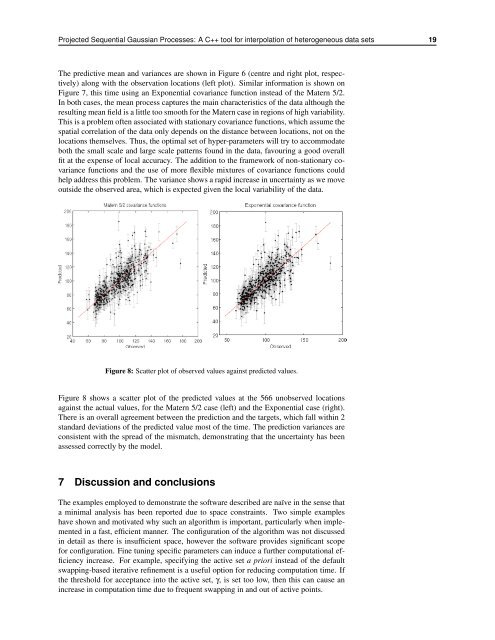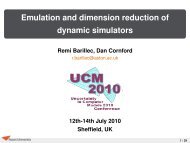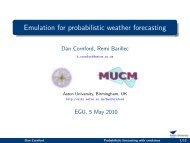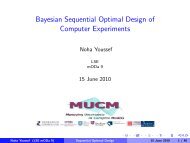Projected Sequential Gaussian Processes: A C++ tool for ... - MUCM
Projected Sequential Gaussian Processes: A C++ tool for ... - MUCM
Projected Sequential Gaussian Processes: A C++ tool for ... - MUCM
Create successful ePaper yourself
Turn your PDF publications into a flip-book with our unique Google optimized e-Paper software.
<strong>Projected</strong> <strong>Sequential</strong> <strong>Gaussian</strong> <strong>Processes</strong>: A <strong>C++</strong> <strong>tool</strong> <strong>for</strong> interpolation of heterogeneous data sets 19<br />
The predictive mean and variances are shown in Figure 6 (centre and right plot, respectively)<br />
along with the observation locations (left plot). Similar in<strong>for</strong>mation is shown on<br />
Figure 7, this time using an Exponential covariance function instead of the Matern 5/2.<br />
In both cases, the mean process captures the main characteristics of the data although the<br />
resulting mean field is a little too smooth <strong>for</strong> the Matern case in regions of high variability.<br />
This is a problem often associated with stationary covariance functions, which assume the<br />
spatial correlation of the data only depends on the distance between locations, not on the<br />
locations themselves. Thus, the optimal set of hyper-parameters will try to accommodate<br />
both the small scale and large scale patterns found in the data, favouring a good overall<br />
fit at the expense of local accuracy. The addition to the framework of non-stationary covariance<br />
functions and the use of more flexible mixtures of covariance functions could<br />
help address this problem. The variance shows a rapid increase in uncertainty as we move<br />
outside the observed area, which is expected given the local variability of the data.<br />
Figure 8: Scatter plot of observed values against predicted values.<br />
Figure 8 shows a scatter plot of the predicted values at the 566 unobserved locations<br />
against the actual values, <strong>for</strong> the Matern 5/2 case (left) and the Exponential case (right).<br />
There is an overall agreement between the prediction and the targets, which fall within 2<br />
standard deviations of the predicted value most of the time. The prediction variances are<br />
consistent with the spread of the mismatch, demonstrating that the uncertainty has been<br />
assessed correctly by the model.<br />
7 Discussion and conclusions<br />
The examples employed to demonstrate the software described are naïve in the sense that<br />
a minimal analysis has been reported due to space constraints. Two simple examples<br />
have shown and motivated why such an algorithm is important, particularly when implemented<br />
in a fast, efficient manner. The configuration of the algorithm was not discussed<br />
in detail as there is insufficient space, however the software provides significant scope<br />
<strong>for</strong> configuration. Fine tuning specific parameters can induce a further computational efficiency<br />
increase. For example, specifying the active set a priori instead of the default<br />
swapping-based iterative refinement is a useful option <strong>for</strong> reducing computation time. If<br />
the threshold <strong>for</strong> acceptance into the active set, γ, is set too low, then this can cause an<br />
increase in computation time due to frequent swapping in and out of active points.






